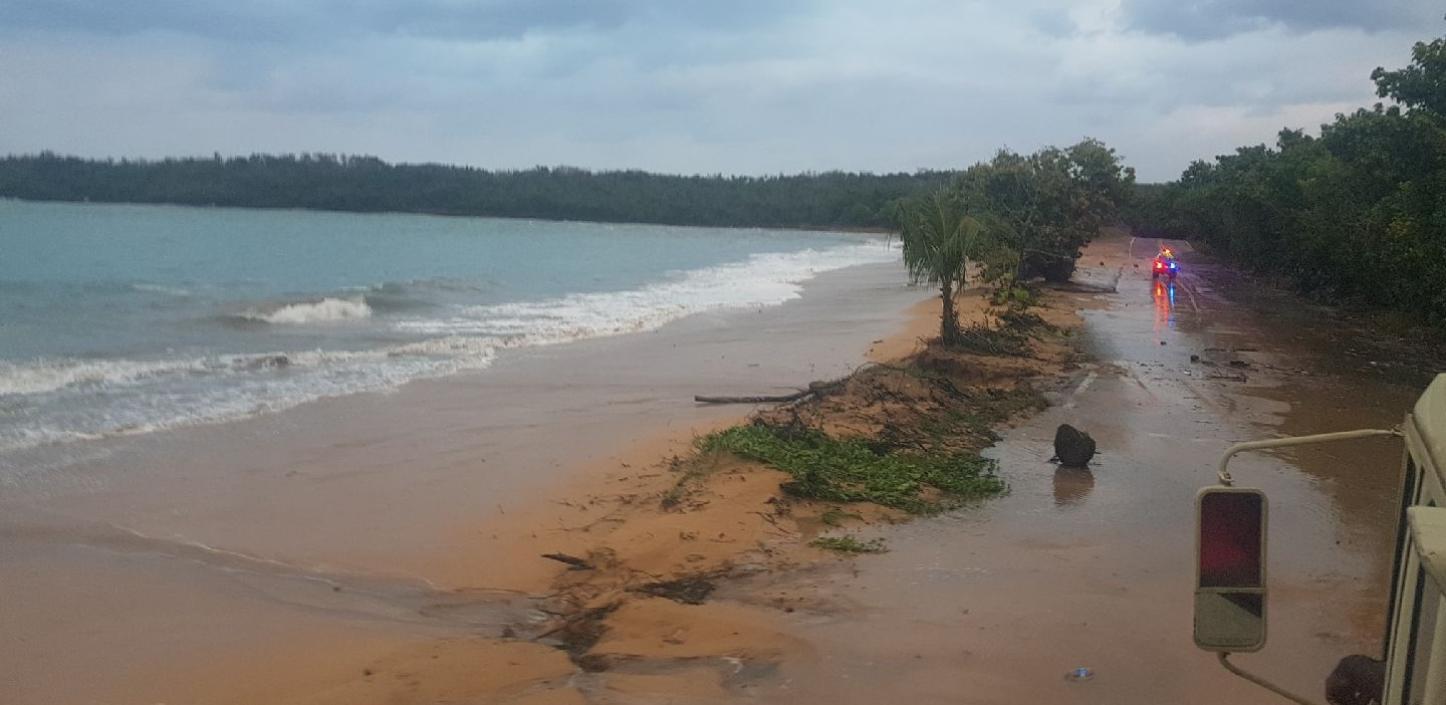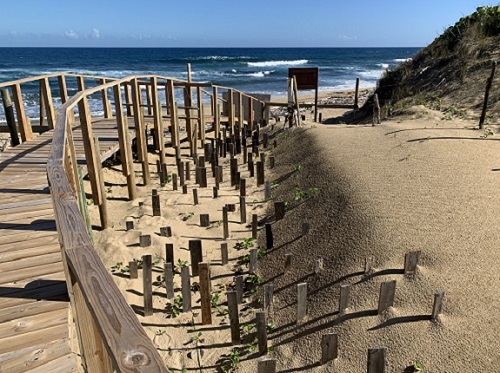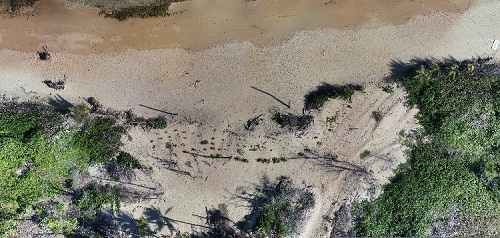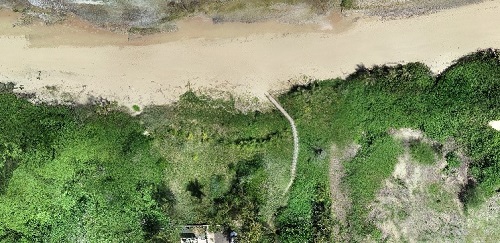
Case Study: Vida Marina at the University of Puerto Rico Aguadilla
Strengthening the Resilience of the Coast of Puerto Rico to Extreme Weather and Climate Change through the Ecological Restoration of its Coastal Sand Dunes
Table of Contents
- Key Information
- Transferable Strategies
- Project Overview
- Challenges and Solutions
- Print this Case Study
Key Information
|
Project Type |
Project implementation and monitoring | ||
| Theme | Outreach and engagement: Vida Marina at the University of Puerto Rico at Aguadilla designed a community-based approach for sand dune restoration, including developing strong partnerships with local community members and educating residents about extreme weather events and the importance of protecting dune habitat. |
||
| Keywords | Dune restoration, sand trapping, vegetation enhancement, hazard mitigation, biomimicry, community engagement | ||
| Organization (Type) | Vida Marina: Center for Conservation and Ecological Restoration at the University of Puerto Rico at Aguadilla (University) | ||
| Project Contacts (as of 2022) |
Robert J. Mayer, Ph.D., Principal Investigator and Project Director, robert.mayer@upr.edu | ||
| Award Amount1 and Year | NFWF Award: $467,571 | Match Amount: $648,968 | Award Year: 2018 |
| Location | Puerto Rico | ||
| Partners | Puerto Rico Department of Natural and Environmental Resources, University of Wisconsin–Madison Earth Partnership Program | ||
| Multimedia and Additional Links2 |
|
||
1 The award amount does not necessarily reflect the total project cost. The match amount is based on the project proposal information. 2 Disclaimer: The opinions expressed in the multimedia and additional relevant links are those of the project team and their partners only and do not necessarily reflect the views of the National Fish and Wildlife Foundation (NFWF).
Transferable Strategies from this Case Study
- Test novel approaches: Performing small-scale projects that incorporate long-term monitoring, when possible, can demonstrate an approach’s effectiveness and garner support from permitting authorities and communities.
- Involve local communities: Involving citizens and local school groups in restoration activities creates a reliable volunteer base, spreads awareness, and promotes understanding of restoration techniques. It also fosters environmental stewardship, as participants see and experience firsthand the effects of human and natural disaster–related environmental degradation. This experiential learning can help inspire community members to protect and conserve vulnerable ecosystems now and in the future.
- Utilize media outlets: Speaking with media outlets when appropriate can raise project visibility and may result in increased awareness of coastal resilience challenges in a community, in addition to increased project support.
Project Overview: Strengthening the Resilience of the Coast of Puerto Rico to Extreme Weather and Climate Change Through the Ecological Restoration of its Coastal Sand Dunes
|
Biomimicry is the practice of designing solutions that imitate nature or natural processes. Biomimicry matrices are resistant to strong wave action and wind, are adjustable, and are highly effective in creating uniform sand accumulation. The matrices also protect new dune-stabilizing plantings. The team is driving small pieces of wood, approximately 3 feet long, into the sand to promote natural sand accumulation. Created from disassembled wooden pallets, the stakes can be raised as sand accumulates. Because they become stronger over time, biomimicry matrices are a sustainable, long-term solution. |
A team of students, citizens, and researchers from Vida Marina is using nature as a model to help restore ravaged sand dunes on the north shore of Puerto Rico. The team is creating biomimicry matrices (Figure 1) to help stabilize the dunes, promote uniform sand accumulation, and protect new dune plantings. The team is also installing wooden boardwalks at critical beach access points to reduce pedestrian impact on the dunes. Outreach, workshops, and environmental education programs have played an instrumental role in enlisting volunteers to help accomplish this work while instilling a lasting community appreciation of the ecological importance of the dunes.
The north shore of Puerto Rico is home to almost 50 percent of the island’s sand dunes, which provide important ecosystem services such as nesting habitat for hawksbill turtles and protection of critical infrastructure and communities from coastal flooding and storm surge. However, past commercial and illegal sand extraction and heavy foot traffic from beachgoers reduced the size of the dunes and their ability to act as natural barriers. Hurricanes Irma and Maria in 2017 and a winter storm in 2018 also severely impacted the already fragile dunes. After these devastating storms, the U.S. Department of Homeland Security’s Federal Emergency Management Agency asked Vida Marina to assess the condition of the dunes. Vida Marina used the assessment to inform site selection for this project, identifying 23 priority sites for restoration. As of 2021, the team has completed restoration of all 23 sites.
Challenges and Solutions

Hard infrastructure, such as seawalls and rip rap, was historically used to protect the north coast’s shorelines. However, in addition to being costly to repair and maintain, these methods can exacerbate erosion and disrupt natural sand accumulation. Obtaining government support for the biomimicry matrices was challenging because authorities were unfamiliar with the benefits of this nature-based solution. Another challenge was the community did not appreciate or was unaware of the dune ecosystems’ importance. The Vida Marina team used outreach and engagement to overcome these challenges.
Permitters’ Lack of Experience with Nature-Based Solutions
Challenge:
Vida Marina needed permits from the Puerto Rico Department of Natural and Environmental Resources (DNER) to initiate the project. The DNER demonstrated great interest in the project during proposal writing and project planning but was slow in issuing permits to Vida Marina. In the wake of hurricanes Irma and Maria, government agencies faced financial and administrative challenges which contributed to delays in permitting, contract signing, and other transactions. High employee turnover at the DNER also made it difficult for the team to build productive, lasting relationships with permitters.

Solutions:
- Promote the project goals and benefits: The team spoke with local TV and other media outlets about the project and its goals and benefits, which raised its visibility and helped the team gain support for implementation.
- Demonstrate effectiveness: Vida Marina has been performing ecological restoration projects along the north shore of Puerto Rico since 2007. While these efforts were on a smaller scale than the current project, they were effective in restoring the dune ecosystems. The restored dunes withstood the 2017 and 2018 storms’ impact with minimal loss of sand and vegetation cover, further illustrating the utility of the nature-based approaches. The team shared data and photos from these prior projects through local media outlets and Vida Marina’s social media accounts. The team also hosted site visits to restoration locations so that community members and government representatives could see firsthand the effectiveness of Vida Marina’s nature-based approaches.

2020, Pedro Albizu Campos, Bajuras, Isabela, post-restoration (Vida Marina). - Conduct monitoring: Vida Marina monitored the restoration sites every other month during the three-year project period. The team conducted site visits and collected 3D aerial imagery using drones and photogrammetry software, which extracts 3D information from photographs. Monitoring data showed improvements in habitat extent, vegetation range and cover, and dune stabilization. Monitoring results, communicated to the public through media outlets and site visits, also demonstrated to the community and permitters the utility and reliablility of the restoration strategy.
Limited Community Stewardship
Challenge:
Historic legal and illegal sand extraction and heavy foot and vehicle traffic on the dunes contributed to their serious degradation over time. The community also had limited awareness of the importance of the dunes and the ecosystem services they provide, such as protecting infrastructure and supporting community resilience. This lack of awareness contributed to the continued exploitation of this fragile ecosystem.
Solutions:
|
UW-Madison’s LEP engages youth and families in culturally based ecological restoration. The program emphasizes environmental stewardship alongside culturally authentic resources, and citizen science skills such as data collection, analysis, habitat restoration, and water stewardship. As part of this partnership, Vida Marina offers a week-long training for 15 K-12 teachers each year at the “EP Institute.” Graduate-level credits from UW-Madison are available to participating teachers. |
- Engage educators and students: Vida Marina and the University of Wisconsin–Madison (UW-Madison) Latino Earth Partnership (LEP) offered workshops throughout the island to raise awareness of dune restoration activities. Student staff members from Vida Marina visited schools to train K-12 students on the ecological restoration of Puerto Rico’s sand dunes. As part of the trainings, students participated in dune restoration activities and gained hands-on experience while providing Vida Marina with an enthusiastic volunteer workforce.
- Engage in community outreach: The team promoted using nature-based techniques through volunteer days, workshops, trainings, social media, and media coverage in newspapers, local TV, and radio. Undergraduate student staff from Vida Marina also gave informative talks in community centers and at local companies seeking volunteer opportunities. These education efforts have increased community understanding of the ecological and social importance of the dune systems and prompted many community members to volunteer their time to the projects. They also increased community capacity by educating community members in nature-based solution techniques.
Print this Case Study (PDF version)